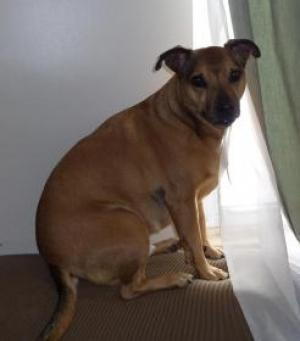Obesity in Our Pets: Make a Resolution to Keep Your Pet at a Healthy Weight
- posted: Dec. 29, 2018
 Obesity in Pets
Obesity in Pets
One of the top New Year’s resolutions has to be losing weight. We all vow to exercise and take off those extra pounds we’ve gained by eating all the tasty holiday food offerings between Thanksgiving and Christmas.
But what about our pets? Obesity in pets is a real problem and it is impacting the health and lifespans of our four-legged friends. Nearly 60% of dogs and cats in the United States are overweight. And obesity can affect other species as well—rabbits, pot-bellied pigs, birds and other animals can also be overfed and become overweight.
A study done by Purina done many years ago found that dogs fed a restricted diet lived 1.8 years longer than dogs who were allowed to eat as much as they wanted. Dogs and cats who maintain a healthy weight are much less likely to develop serious health issues such as diabetes or orthopedic problems.
What can you do to keep your pet trim and fit or to help him or her lose weight?
- Limit food portions—feeding directions on dog and cat food packaging often overestimate the amount of food an average dog or cat needs. Most housecats need about ¼ to ½ cup of dry food per day, and, a Labrador Retriever needs about 2 cups of food total per day. Your pet may need a little more or less depending on their activity level. Ask our vets about your pet’s daily caloric needs.
- Feed an appropriate diet—dog or cat foods that state that they can be fed to “all life stages” on the package are actually geared for puppies or kittens and may have too many calories for an adult or senior pet. Try to choose a pet food that is specific to your pet’s stage of life.
- Limit treats and table food—just like people snacking on too many Christmas cookies and holiday treats, dogs or cats who are fed excessive amounts of treats or who are fed table foods often exceed their daily calorie needs and gain weight. You don’t have to cut out treats entirely, but think of them as part of your pet’s daily meal and so limit treats and/or reduce the amount of daily rations if you pet eats lots of snacks. Try not to feed table foods to pets as they can not only contribute to weight gain but may also cause stomach upset or other problems. Feeding one hotdog to a 20lb dog would be equivalent to the calories consumed by a person eating three hamburgers. One potato chip for a 10 pound cat is the caloric equivalent of half a hamburger for a person. Think twice before sharing your meal with your pet. What seems like a harmless bite here or there can quickly add up to too many calories and too much dietary fat for your fur baby.
- Exercise—this benefits both you and your pet! What better way to stay in shape than by staying active together? Even if you have a yard where your pet can run, chances are, he is not as active as you think. Plan for structured activities. Walk or run with your dog, play fetch in the yard, toss some toys indoors or have your cat play with a laser light in the house. Interactive feeders provide exercise and dispense daily rations, a win-win!
Make a New Year’s Resolution for both you and your pet to stay active and healthy. Ask our vets about proper diet and exercise for your pets to help maintain a healthy weight in 2019 and beyond!
This blog brought to you by the Patton Veterinary Hospital serving Red Lion, York and the surrounding communities.
https://www.petmd.com/dog/centers/nutrition/slideshows/common-snacks-leading-to-portly-pets
Location
Patton Veterinary Hospital
425 E Broadway
Red Lion, PA 17356
